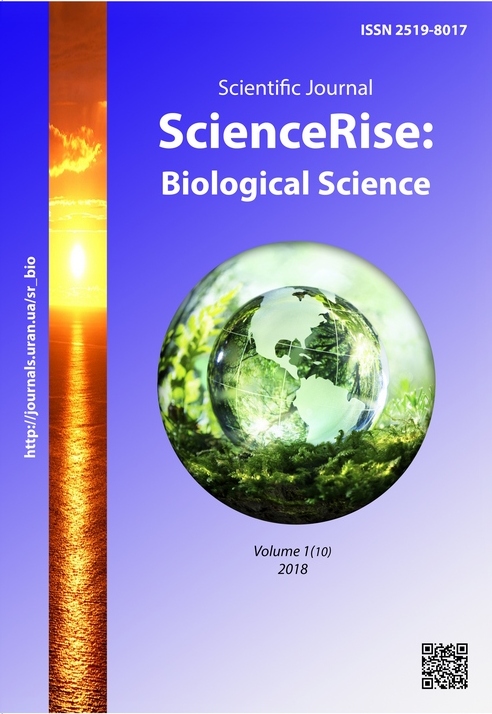Introduction possibilities of conifers in the microlandscape dendrocompositions of Kryvyi Rih botanical garden of NAS of Ukraine
DOI:
https://doi.org/10.15587/2519-8025.2018.124559Keywords:
conifers, microlandscape dendrocompositions, introduction, decorativeness, living state, gardening, prospectiveness, Kryvyi Rih regionAbstract
The aim of the study is to determine main effective microcompositional solutions with using conifers and shrubs in the Cryvyj Rih botanical garden of NAS of Ukraine. The tasks included the study of principles of the construction and taxonomic structure of microlandscape dendrocompositions, evaluation of living states, biomorphological characteristics and decorativeness of each variety and cultivar of coniferous introducents. The objects of the studies were coniferous introducents, used in microlandscape dendrocompositions of the collection fund of CBG. The evaluation of the living state of plants was realized by the methodology of V.T. Yarmishko (2002), decorativeness – T. G. Tamberg and T.N. Ulianova (1969), biomorphological analysis – by I.G. Serebriakov (1962), distribution by the crown form – by A.I. Kolesnikov (1974). There were separated 21 nature dendrocompositions, which taxonomic composition counts 13 varieties, 38 cultivars of 9 geni and 4 families. The main families in these compositions are Сupressaceae and Pinaceae. The Juniperus L. genus is the most widespread – 2 varieties and 14 cultivars. The tree living form is inherent to 28 taxons of conifers, bush – 23 taxons. At creating dendrocompositions, there were used ecological, system and physionomic principles. Our analysis divided them in pure coniferous (14) and mixed coniferous-foliar (7), mono-variant (4) and multi-variant (17) of 2-4 varieties. The age of plants was 15-35 years.
Conifers were divided in 7 groups by form: conic (49 %), spread (25 %), column-like (12 %), creeping (6 %), spheric (4%), weeping (2 %), pillow-like (2%). The following 3 groups wee separated by the needles coloration: green (43%), yellow and yellow-motley (30%), grey-blue (27 %). Among the whole number of studied coniferous plants the high living state level was observed in 80% of units, and decorative one – in 74%. All aforesaid microlandscape dendrocompositions of conifers are perspective for using in gardening of territories of settlements of the steppe zone of Ukraine of different destinations
References
- Makhrova T. G., Sapelin A. Iu. (2016). Khvoinye introdutcenty v zelenykh nasazhdeniyakh VDNKh [Coniferous introduents in green plantations EANE]. Lesnoy vestnik, 5, 191–198.
- Pushkar, V. V. (2004). Khvoini u sadovo-parkovomu budivnytstvi [Conifers in garden and park construction]. Kyiv: Vyd-vo DAKKKiM, 284.
- Miakushko, V. K., Kuznetcov, S. I., Pushkar, V. V. (1985). Taksonomicheskiyi sostav khvoinykh i ego ispolzovanie v gorodskikh zelenykh nasazhdeniyakh [Taxonomic composition of conifers and its use in urban green plantations]. Sbornik nauchnykh trudov USKhA. Kyiv: Izd. RPO USKhA, 54–57.
- Pushkar, V. V. (2013). Khvoini u miskomu seredovyshchi [Conifers in the urban environment]. Naukovyi visnyk NLTU Ukrainy, 23 (9), 264–270.
- Dubovitckaia, O. Iu., Zolotareva, E. V. (2014). Dekorativnolistvennye i khvoinye derevia i kustarniki dlia ozeleneniia naselennykh mest [Decorative and coniferous trees and shrubs for landscaping populated places]. Nauchnye vedomosti BelGU. Seriya Estestvennye nauki, 23 (194), 38–43.
- Neretina, M. I. (2006). Khvoinye rasteniya [Coniferous plants]. Moscow: Izdatelskii dom MSP, 96.
- Poliakov, A. P., Suslova, E. P. (2004). Khvoinye na iugo-vostoke Ukrainy [Conifers in the south-east of Ukraine]. Donetck, 197.
- Terlyha, N. S., Danylchuk, O. V., Yukhymenko, Iu. S., Fedorovskyi, V. D., Danylchuk, N. M. (2015). Kultyvovana dendroflora parkiv i skveriv Kryvoho Rohu: istorychni aspekty formuvannia ta suchasnyi stan [Cultivated dendroflora of parks and parks of Kryviy Rih: historical aspects of formation and modern state]. Visnyk Kharkivskoho natsionalnoho universytetu. Seriya: Biolohiya, 2 (35), 93–101.
- Sokolov, S. Ya., Shishkin, B. K. (Eds.) (1949). Derevia i kustarniki SSSR: Golosemennye [Trees and shrubs of the USSR: gymnosperms]. Moscow-Leningrad: Izd-vo AN SSSR, 462.
- Kuznetcov, S. I., Chuprina, P. Ia., Podgornyi, Iu. K. et. al. (1985). Derevia i kustarniki, kultiviruemye v Ukrainskoi SSR. Golosemennye [Trees and shrubs cultivated in the Ukrainian SSR. Starvation]. Kyiv: Naukova Dumka, 200.
- Iarmishko, V. T. (2002). Diagnostika povrezhdeniy i otcenka zhiznennogo sostoianiya derevev i drevostoev v usloviyakh promyshlennogo atmosfernogo zagriazneniya [Diagnosis of damage and assessment of the living conditions of trees and stands in conditions of industrial atmospheric pollution]. Metody izucheniya lesnykh soobshchestv. Sankt-Peterburg: NII Khimii SPbGU, 154–165.
- Serebriakov, I. G. (1962). Ekologicheskaia morfologiya rasteniy. Zhiznennye formy pokrytosemennykh i khvoinikh [Ecological morphology of plants. Life forms of angiosperms and conifers]. Moscow: Vysshaya shkola, 379.
- Kolesnikov, A. I. (1974). Dekorativnaia dendrologiya [Decorative dendrology]. Moscow: Lesnaia promyshlennost, 704.
- Metodicheskie ukazaniya po izucheniyu kollektcii dekorativnykh kultur [Methodical instructions for studying the collection of decorative cultures] (1969). Leningrad: NII rastenievodstva im. N. I. Vavilova, 19.
- Zvit z vykonannia naukovo-tekhnichnoi roboty «Rozrobka prohramy ozelenennia mista Mariupolia». Available at: http://marsovet.org.ua/upload/documents/file/7.19-1571-11499106087.pdf
- Rubcov, L. I. (1977). Derev'ya i kustarniki v landshaftnoy arhitekture [Trees and shrubs in landscape architecture]. Kyiv: Naykova Dumka, 272.
Downloads
Published
How to Cite
Issue
Section
License
Copyright (c) 2018 Antonina Mazur, Ivan Korshikov, Lyudmyla Boyko, Yulia Yukhimenko, Oleg Krasnoshtan, Natalia Danulchuk, Olena Lapteva

This work is licensed under a Creative Commons Attribution 4.0 International License.
Our journal abides by the Creative Commons CC BY copyright rights and permissions for open access journals.
Authors, who are published in this journal, agree to the following conditions:
1. The authors reserve the right to authorship of the work and pass the first publication right of this work to the journal under the terms of a Creative Commons CC BY, which allows others to freely distribute the published research with the obligatory reference to the authors of the original work and the first publication of the work in this journal.
2. The authors have the right to conclude separate supplement agreements that relate to non-exclusive work distribution in the form in which it has been published by the journal (for example, to upload the work to the online storage of the journal or publish it as part of a monograph), provided that the reference to the first publication of the work in this journal is included.









